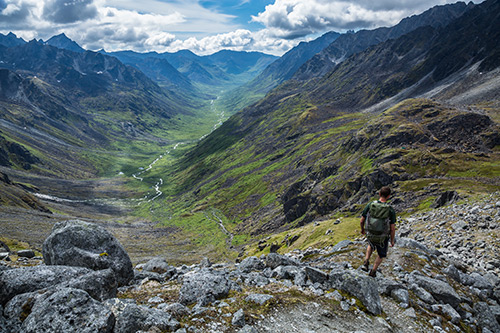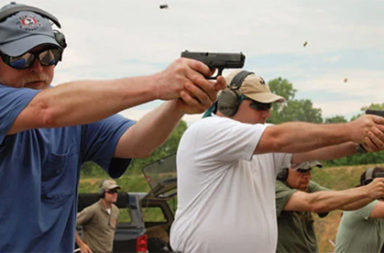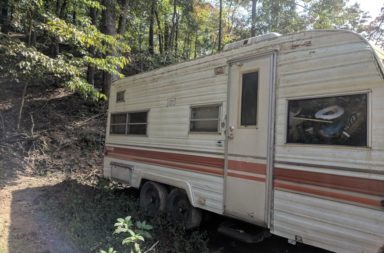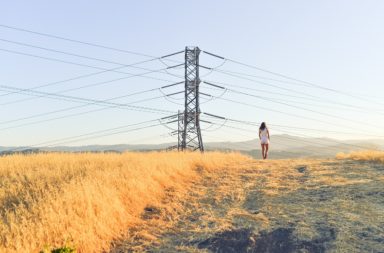
Survival is no simple task.
Training young people on basic survival techniques and wilderness tasks is a useful tool for development. Survivalists can help them through wilderness scenarios and put them in a leadership situation to help them deal with stressful situations. In the wild, there might be dangers lurking at every turn. But, with a little planning and some basic tools and techniques, a survivalist can survive almost any emergency situation.
Here are the 22 basics to surviving the wild.
![]()
1. Prepare to be Uncomfortable
The first thing that you need to remember about any survival situation is that things are probably going to get uncomfortable. This doesn’t mean that you won’t survive, but it’s important to prepare yourself to deal with extreme heat or cold, as well as hunger and thirst.
![]()
2. Avoid Dangerous Situations When Possible
Before you think about what you might need to survive in the wilderness, it’s always best to remember to avoid a life and death situations whenever possible. That means that if you’re going into a situation, like remote areas, especially if they are particularly hot or cold, you should always let someone know where you’re going. In the same vein, whenever you’re going into a situation that might need survival skills, you should always bring some way to communicate with the outside world, like a cell phone, or walkie-talkie.
![]()
3. Pack for the Unexpected
Emergency packing is key (see below).
![]()
4. Always Carry Emergency Communication
If you know that there is some small chance that you will be forced into a survival situation, the best thing to do is make sure that you’re prepared. Later, we’ll go into greater detail of what are the very bare necessities that you should keep with you. Sometimes the difference between life and death can be a few emergency supplies. Another common way to pack emergency supplies is to use a survival stick, which is a partially hollowed out walking stick that usually has basic supplies hidden in the handle.
![]()
5. But Don’t Overpack
Just like not having emergency supplies or an emergency bag can be a bad thing, packing too many supplies can pose just as much of a risk. The goal in packing for emergency situations is to have enough supplies to help you to survive until you are rescued, but not so many supplies that you don’t always have room to keep them with or they become too cumbersome to carry with you in the wilderness. For example, keeping several liters of water with you might be helpful in some situations, but they might be too heavy to carry. For this reason, getting lightweight supplies is imperative.
![]()
6. Prioritize
Surviving in the wilderness is all about prioritization of your survival needs. First, deal with any injuries, especially bleeding because this could kill you in a few minutes. Then consider your environment. If your environment is extreme enough you may only survive a few hours without shelter, so the first thing you need to do is make some sort of shelter and build a fire. After shelter, you need to look for water because you can only survive a few days without water. Lastly, you can survive up to a few weeks without food, so look for that last. It’s useless to look for food if you are about to die of hypothermia.
Materials in Your Emergency Pack
Survivor Tip: preparing with the right materials is key to surviving any situation. A good survival kit has the most necessary things that might be needed. Things like maps and compass are usually helpful, but not always necessary if the area is easy to navigate. Here are the bare essentials of what you might need in a survival kit. Keep in mind that this pack is designed to be small and light enough that you can keep somewhere close to you at all times.

7. First Aid
In a survival situation, there is a very high likelihood that you or another person might have been injured. A first-aid kit is critical to making sure that you survive long enough for any help to arrive. This kit should include enough bandages and gauze to stop any bleeding and wrap injured areas.
 8. Knife/Multitool
8. Knife/Multitool
A good multitool is one of the heavier, but most important parts of your emergency pack. There is an almost unlimited number of uses for a good multitool and at the very least you’re going to need a knife to cut bandages, wood, or other material for food or shelter.
 9. Tent/Tarp and Twine
9. Tent/Tarp and Twine
The value of a tent is quite obvious but, in the case where you can’t fit a small tent in your bag, a tarp will usually work just fine. A tarp, in conjunction with your multi-tool will allow for a basic shelter to keep you out the rain or sun. The twine will help you to make your shelter and is useful to tie other small objects as well. When you’re done do a quick shelter review to make sure that your shelter is as secure as protected as possible.
 10. Sleeping Bag/ Emergency Blanket
10. Sleeping Bag/ Emergency Blanket
A lightweight emergency sleeping bag could be the difference between you and hypothermia if the nights get cold enough, but you can also include an emergency blanket. Emergency blankets are usually reflective blankets that help keep you warm if they’re wrapped around you but can also be used as a heat shield is placed on top of your shelter, helping to block some of the heat
 11. Maps and Compass
11. Maps and Compass
In a lot of cases, you know that if you travel long enough in a certain direction you’ll reach an area with people. When you’re close to a road it’s easy to just follow the rod, but if you’re in the wilderness and there aren’t any roads to easily follow, a good survivalist should have maps and a compass so they can travel towards the nearest populated area and make sure that they aren’t walking in circles.
 12. Materials to Start a Fire
12. Materials to Start a Fire
The easiest method to start a fire is to pack a lighter or matches, but they each only have a small number of uses and can be useless if they get wet. Another option is to pack flint. Flint allows you to get a good enough spark to burn any kindling you’ve collected. If you don’t have flint, you can also make a bow drill to create enough friction and heat to start a fire. The easiest option is to pack a lighter, but be prepared to start a fire other ways if that doesn’t work.
 13. Purification Tablets
13. Purification Tablets
You need to drink several liters of water a day. Purification tablets are necessary if you end up in an area that doesn’t have any fresh quickly moving water. These tablets can be put in water and will kill harmful bacteria after a short amount of time.
 14. Light Metal Container
14. Light Metal Container
A light container to store the rest of your emergency equipment in is crucial. Metal, while being heavier than plastic containers, is less likely to break and can be used to cook food or boil water in.
Surviving the Wild
Survivor Tip: the basic techniques for training young people to make things like traps and snares or to do a simple shelter review.
![]()
15. Make Sure You’re Not Hurt
The first and most important thing that you need to do is make sure you’re area is safe and stop any bleeding if you have any. If you’re bleeding you need to do whatever you can to try to block the blood flow so that your blood can coagulate. Ideally, this is where you should use fresh gauze, but lacking that any sort of clothing or absorbent fabric will do. Once you’ve slowed the bleeding you need to wrap the bandages tightly enough that you can move.
 16. Make a Shelter
16. Make a Shelter
If you’re in an extreme climate, especially if you’re in arctic regions you need to make a shelter to block out the elements. This can be as simple as finding sticks, leaning them together in a triangle, tying the top and putting whatever you can find on the outside (e.g. leaves, bark, other branches). Of course, this process will be easier and end up in a higher quality product if you packed good emergency supplies.
 17. Build a Fire
17. Build a Fire
If your area is cold, you need to build a fire to heat yourself up. If you packed a lighter, matches, or flint this will be as easy as finding kindling to start the fire and wood to burn and some patience. If you don’t have these items, you can try to make a fire from friction using either a bow drill—which is a piece of curved wood with a string tied at both ends which holds a stick in the center—or try to spin a small stick quickly enough to create heat friction. This heat can be used to light the kindling.
 18. Make a Signal
18. Make a Signal
If you don’t know where you are and don’t have a map or a compass, you should try to use your fire to make a signal. The easiest way to do this is to add grass or green leaves to your fire. This will produce a thick pillar of smoke that will help rescuers find your location.
 19. Find and Purify Water
19. Find and Purify Water
If it seems like you might not be immediately rescued, you need to find water. In most areas, you can find water in small streams, in the snow, or in rain. For snow and rain that you catch off a plant or in a tarp you can safely drink it, but for water that you find in smaller lakes or streams, you need to filter it first. The easiest way to do this is to put the water in a container and use water purification tablets. If you don’t have purification filters or tablets then you should try to boiling water in a small heat safe container. Boiling water can kill most of the water’s harmful bacteria.
 20. Find Plants to Eat
20. Find Plants to Eat
If you have a good source of clean water, you need to find food. You can find recognizable food plants in the wild like berries or small nuts, but you should be sure that you recognize the plant before you eat it as many plants are toxic or poisonous to humans.
 21. Catch Food
21. Catch Food
The harder option of finding things to eat is catching and killing wild animals. Some small animals and fish can be caught by sharpening a stick, like a survival stick if you packed one, with a knife and using it as a simple spear. Another Option is to make traps and snares, though these are more difficult for untrained survivalist and might not be worth the effort unless you are planning on being in the area for a while.
 22. Stay Calm and Make a Plan
22. Stay Calm and Make a Plan
Since it might take some time for you to be rescued, you need to stay calm and make a plan for what to do next. If other people know where you are and you can reasonably expect that they are already searching for you it might be best just to wait it out until help arrives. If nobody knows where you are then you might have to do your best traveling to the nearest populated area. If you have maps and a compass it will be easier to travel if necessary, but if you lack these items try to mark direction by some distant object like a mountain, or if you know how to, stars.
Conclusion
Survivalists will need to know certain wilderness tasks for surviving in the wild, but if you stay calm and pay attention to your environment you should be able to survive long enough for help to arrive. If you find yourself in a leadership situation a survivalist should think of common emergency scenarios and try to avoid before they happen. This can help you avoid a dangerous emergency situation.


